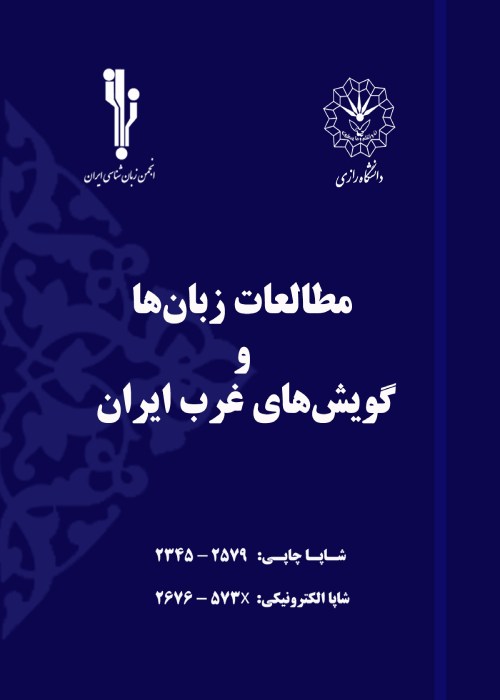A Cognitive Approach to the Text Worlds of Chair by Shirko Bikas based on Text World Theory
The present study was conducted to examine cognitively the text worlds in the text of Shirkoo Bikas's Chair based on the theoretical framework of the text worlds proposed by Werth (1999). The authors seek to demonstrate how the cognitive mechanism proposed by Shirkoo Bakas shapes the formation of a complete mental image in the reader's mind. How is the nature of Shirkoo's new poetic experience in Chair represented? Based on the questions raised in this study, the research hypotheses are formulated as follows: The nature of Shirkoo's poetic experience in the novel poem Chair can be understood based on the theory of text worlds, through the process of constructing deictic-ontological sub-worlds. The cognitive mechanism adopted by this poet for forming a complete mental image in the reader involves expanding and elaborating world-building elements and advance-function propositions, combined with the reader's prior knowledge. Since the text world and the sub-world are structurally equivalent in terms of the elements of world-building and advance-function propositions, the expansion of various sub-worlds provides the reader with more details to construct a mental image.
Literature Review:
Among relevant works on the Text World approach one can refer to Afrashi (2015) Dehghan (2020) and Sadeghi Esfahani (2010). In addition, Golfam et al. (2012) highlighted layers of meaning, and Talaei & Abbasi (2019) explored historical narratives. Gholamhosseinzadeh & Rafaei Ghadimi (2020) analyzed Persian poetry, while Gavins (2001, 2003) dissected novels using text worlds theory. Lahy (2006) focused on place representation in poetry. Whitley (2010) studied Ishiguro's novels, and Halam (2013) applied text world theory to short stories.
A descriptive-analytical approach was employed, anchored in the theory of text worlds, with data sourced from Shirkoo's Chair using a documentary method. The novel Chair was chosen due to its innovative poetic narrative, supplemented by an interview with Shirkoo. The analysis focused on selective data relevant to research questions, emphasizing Shirkoo's vivid imagination, even in translation. Hypotheses were tested by extracting data into sub-paragraphs for independent analysis. Diagrams illustrating text worlds aided in comprehending the analyses.
Theoretical Framework:
The theory of text worlds is a discourse-processing linguistic theory whose initial proposal was first suggested by an English linguist in a series of articles published between the 1980s and 1990s (Lahy, 2014: 284). The complete theory was then presented in the form of a book titled Text Worlds: Representing Conceptual Space in Discourse after Werth died in 1999. After his death, researchers such as Stockwell (2002), Gavins (2000, 2001, 2003, 2007), and Lahy (2003, 2004, 2006) made significant efforts in the expansion, development, and necessary revisions of the theory of text worlds. The theory of text worlds, as a discourse framework, not only addresses how a particular text is constructed but also how the context surrounding that text affects its production and reception (Gavins, 2007: 8). The first level of the theory of text worlds provides a tool for examining how a spectrum of contextual factors influences the construction and understanding of a specific discourse. These mental representations are known as text worlds. The second level of this theory focuses on this domain of conceptual activity and provides a framework through which one can examine the precise structure and cognitive effects of individual mental representations (Gavins,2003:10). The third and final level of discourse proposed by Werth is the sub-worlds. Sub-worlds emerge from within the text world and represent a kind of realized substitution of the parameters of the text world.
The narrative of the novel Poem Chair is Kurdish and is narrated in a city which is Sulaymaniyah. The narrator at the beginning of the narrative of the novel poem Chair is Shirko himself, who talks about his characteristics and his poetic experience. In the middle of the narrative, with a change in perspective, Chair becomes the narrator and recounts the story of its life from birth to death. In this work, human characteristics were attributed to the chair; it walked, talked to itself, and interacted with others, being present as an actor on all levels of the text worlds. The examination of hypotheses and answering questions was based on dividing the extracted data into distinct para-discourses that were explored and analyzed in the previous section, and here are the cognitive results presented accordingly:In discourse 1, the reader starts constructing a mental world by using information related to the world-building elements and combining it with their background knowledge. Through this process, they establish the spatial and temporal setting of the world. Then, by providing further details about themselves, they create the first ontological sub-world. In discourse 2, the narrator delved into expressing their poetic experience using a type of referential-cognitive sub-world. The narrator appeared in the guise of poetry to articulate their poetic experience, taking on the form of both a poem and a narrative, transforming into prose and a play as well. In Para-discourse 3, the narrator employed a figurative approach to discuss an abstract concept such as loneliness. Using a metaphor of personification, they attributed a bird-like structure to the concept, as if it were sitting on a chair. In fact, by doing so, the narrator prepared the necessary cognitive framework to introduce a new entity named Chair in the reader's mind. This way, they introduced the previously undefined element of Chair as an object in the textual world of the Chair. In discourse 4, the narrator provides more details about the physical appearance of the chair to give the reader a complete image of it. In discourse 5, the deictic sub-world was implicitly internalized through the use of direct quotations, providing a mental image of the place and characters of the birthplace of the chair to the reader. In discourse 6, the mental representation of the discourse shifted from a static arrangement of objects and entities to dynamic physical movement, emphasizing the impact of expanded propositions in creating a mental image in the reader's mind.
- حق عضویت دریافتی صرف حمایت از نشریات عضو و نگهداری، تکمیل و توسعه مگیران میشود.
- پرداخت حق اشتراک و دانلود مقالات اجازه بازنشر آن در سایر رسانههای چاپی و دیجیتال را به کاربر نمیدهد.



